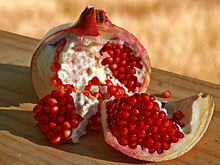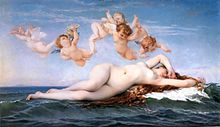Dream caused by the flight of a bee around a pomegranate one second before waking up
| Dream caused by the flight of a bee around a pomegranate one second before waking up |
|---|
| Salvador Dalí , 1944 |
| oil on wood |
| 51 × 41 cm |
|
Thyssen-Bornemisza Museum , Madrid
Link to the picture |
Dream, caused by the flight of a bee around a pomegranate, one second before waking up (Spanish original title: Sueño causado por el vuelo de una abeja alrededor de una granada un segundo antes de despertar ) is an oil painting by the surrealist painter Salvador Dalí from 1944 . It was created during Dalí's eight-year exile in the United States and is one of the most outstanding works of his paranoid-critical creative period.
The painting is now in the Museo Thyssen-Bornemisza in Madrid, along with other works by Dalí .
Emergence
In the spring of 1940, the German Wehrmacht in invaded France , Dalí decided to flee to the United States, where he had taken previously (1934/35 and 1937/38) already two extended trips and the US press as the most important surrealist artists of his Time was celebrated. There Dalí was busy organizing exhibitions, illustrating Hollywood films and magazines, and writing his autobiography and his first novel, which is why only a few paintings were created during his time in exile.
In the 1944 picture Dream, caused by the flight of a bee around a pomegranate, one second before waking up , Dalí dealt with the artistic representation and interpretation of a dream . In doing so, he was guided by Sigmund Freud's theories on psychoanalysis and dream interpretation , which he had been fascinated by since his studies in Madrid in 1922/23. Based on this, Dalí developed his paranoid-critical method , of whose usefulness he was able to convince Freud in a personal meeting in 1938. It made it possible for him to link motifs and symbols that seem to have no rational connection and to objectively convey the unconscious , such as is manifested in dreams or delusions. In this way, he made visual associations open to a wide range of possible interpretations and allowed different levels of meaning to flow into one another. With the help of this method, as he explained in 1962, he was able for the first time to "visually express Freud's discovery of the typical dream with a long plot, as a consequence of the immediacy of a coincidental event that wakes the sleeper".
Image composition
The 51 × 41 cm painting is a seascape painting (possibly near Dalí's residence near Portlligat ) with several set figures. The foreground of the picture is dominated by a naked woman (Dalí's wife and muse Gala ), who hovers over a flat rock slab and seems to be sleeping. A pomegranate , around which a bee is circling, hovers in an angular indentation at the front of the slab of rock protruding from the water . On the right edge of the picture, an overhanging cliff with sparse vegetation rises above the sleeping gala.
The completely calm and smooth sea surface, which extends to the horizon, is broken only by a small rock island. In the right half of the picture, in the background, is an elephant with extremely long, thin and spider-like legs that raise him above the entire scene, walking through the sea. On his blue saddlecloth he carries a large, glass obelisk , the tip and edges of which are chipped or broken off.
The actual action takes place in the center of the picture. A large, orange-colored fish leaps out of an oversized, burst pomegranate that hovers over the sea on the left edge of the picture in the background, and a tiger leaps out of its wide-open mouth, also with its jaws torn open. From this in turn a second tiger leaps out. Both tigers jump down on the lying gala with their paws spread, claws extended and teeth bared. The paw of the tiger in front is lengthened by a rifle, the bayonet of which is pointed at Gala's right upper arm.
Image content
Central chain of symbols

Starting from the left edge of the picture, an arched chain of symbols extends over the center to the right third of the picture. The starting point is the pomegranate that has burst open, the numerous kernels of which are surrounded by pulp and are clearly visible as a symbol of fertility and resurrection. Due to the intense red color, which can stand for love but also blood, it can be interpreted as a symbol for both life and death.
Just like the pomegranate, the fish that arises from it is a traditional Christian symbol ( Eucharistic fish ) and symbol of water, which stands for fertility, life and truth, but also points to the underworld and death. This ambivalence between death and life, death and resurrection, related to water and marine animals, can be found in a religious context, for example, in baptism (immersion vs. emergence) or the story of Jonah and the whale (swallowing vs. spitting out).
This ambiguous symbolism is also continued in the two protruding tigers, albeit weakened, as attributes such as strength, courage and potency are associated with them, but Dalí's portrayal is dominated by the aggressive, violent and instinctual side of the tiger. The ambivalent symbolism finally comes to an end with the bayonet rifle as the end of the chain of symbols, since this only stands for violence, war and death, and represents an immediate threat.
Gala
A stark counterpoint to the violent and threatening-looking central chain of symbols is the vulnerable-looking gala, stretched out almost across the entire width of the picture in a lascivious pose, which also forms the erotic focus in other paintings by Dalí such as Leda Atomica (1949).
Dalí, whose relationship with Gala, who was born in Russia ten years older, was characterized by deep solidarity, devotional desire and sexual obsession, mystified his encounter with her as a predetermined encounter with his ideal image of a female kindred spirit, his divine twin. His deep admiration for Gala is also expressed in his artistic representations of her, which are often based on ancient, mythological figures such as Leda , Helena , or, as indicated here by the dewdrops reminiscent of pearls and the heart-shaped shadow of the pomegranate, Venus or Aphrodite as symbols of beauty.
In fact, Gala was not only a source of artistic inspiration for Dalí, but also a tireless sales manager and exhibition organizer of his art, making Dalí the most financially successful artist of his time.
Elephant with obelisk
In sharp contrast to the central chain of symbols, the drama of which is underlined by the strong and bright colors, there is also the elephant with obelisk in the upper right half of the picture, which is kept rather pale and therefore hardly stands out in color from the sky behind. It is a caricature of Bernini's elephant , a sculpture by the Italian sculptor Gian Lorenzo Bernini in the Piazza della Minerva in Rome, which in turn is inspired by the portrayal of such a figure in Francesco Colonna's novel Hypnerotomachia Poliphili .
The elephant traditionally symbolizes wisdom, strength / power, immortality / divinity and peace. This symbolism is connected with the obelisk, which originally represented the rays of the sun god Re in Egyptian mythology and whose directional shape symbolizes the connection between earth and sky / sun and also has a phallic symbolism. Both the long, filigree legs of the elephant as well as the damage to the obelisk and the pale coloring underline the fragility and endangerment of the symbolized power and potency.
This connection of long-legged elephants with symbols of potency, lust and desire can also be found in later works by Dalí, such as The Temptation of St. Anthony (1946).
interpretation
In this, as Dalí described it, “hand-painted dream photography”, he not only captured the unreality of the dream, but also its complexity. This makes it possible to capture a multifaceted event in a single moment. Just as the sleeper perceives the dream, which lasts only seconds, as a long and complex "film", so the viewer of the picture is also aware of the inherent chronology of the events.
This can be seen in the specific spatial composition of the image, which places the image fragments in a logical conceptual context. The horizon line divides the image into a "real plane" in the foreground, in which the sleeping woman and the dream trigger (bee with pomegranate) are, and into a "dream plane" in the middle and background in which the dream sequence takes place . The dream-triggering motif is reflected in the central chain of symbols. The sting of the bee is represented by the bayonet rifle, the characteristic black and yellow hair can be found in the tigers, which are supposed to represent the body of the bee, and the scaly structure of the fish skin is reminiscent of the compound eye of a bee.
Another special feature of the painting is the multitude of phallic symbols and fertility symbols, which are often shown in contrasting but also strongly linked or merging into one another as in the central chain of symbols, which is often understood as a subtle comment by Dalí on his relationship to Gala.
literature
- Cathrin Klingsöhr-Leroy: Surrealism . Ed .: Uta Grosenick. Taschen, Cologne 2009, ISBN 978-3-8365-1416-3 , pp. 44 f .
- Karina Liebe-Kreutzner: Literary Influences in Salvador Dalí's Work, The Deciphering of Iconography in the Light of Associative Quotation . Philosophical dissertation. Graz 2000.
- Karina Liebe-Kreutzner: Controlled delirium. Literary influences in Dalí's work . In: Lisa Puyplat (Ed.): Salvador Dalí. Facets of an artist of the century . Königshausen & Neumann, Würzburg 2005, ISBN 3-8260-3021-4 , p. 51-65 .
- Werner Faulstich : Image analysis: paintings, photos, advertising images . Scientists-Verlag, Bardowick 2010, ISBN 3-89153-035-8 , p. 55–63 ( full text [accessed August 4, 2010]).
Web links
Individual evidence
- ↑ a b c d e Paloma Alarcó: Salvador Dalí - Dream caused by the Flight of a Bee around a Pomegranate a Second before Waking up (1944). Thyssen-Bornemisza Museum , accessed on August 4, 2010 .
- ^ Love Kreutzner: Literary influences in the work of Salvador Dalís. 2000, p. 253.
- ^ Faulstich: image analyzes. 2010, p. 55.
- ↑ a b c Klingsöhr-Leroy: Surrealism. 2009, p. 44f.
- ^ Faulstich: image analyzes. 2010, p. 56f.
- ^ Love Kreutzner: Literary influences in the work of Salvador Dalís. 2000, p. 83.
- ^ Faulstich: image analyzes. 2010, p. 58f.
- ^ Faulstich: image analyzes. 2010, pp. 56-61.
- ^ Love Kreutzner: Literary influences in the work of Salvador Dalís. 2000, p. 20.


